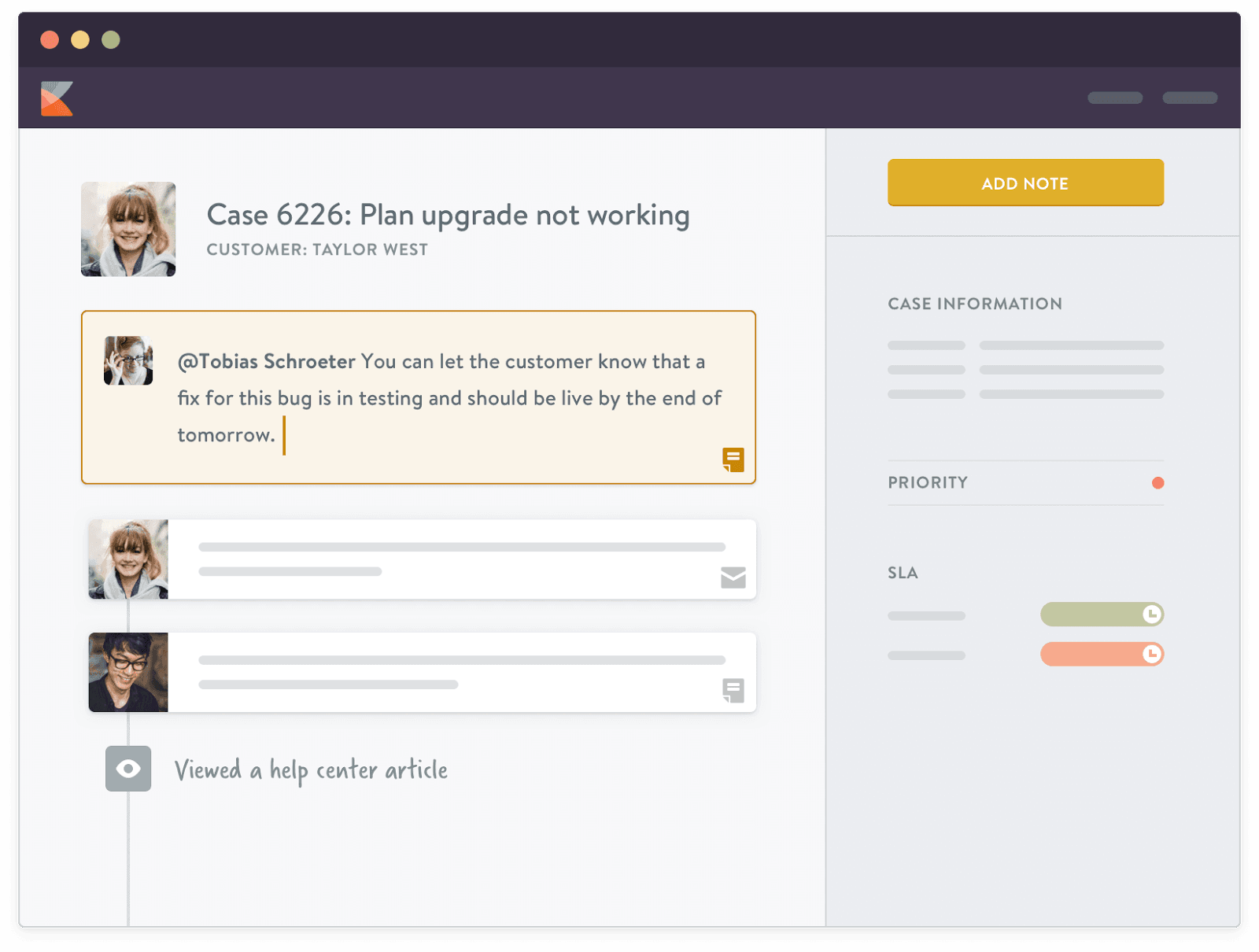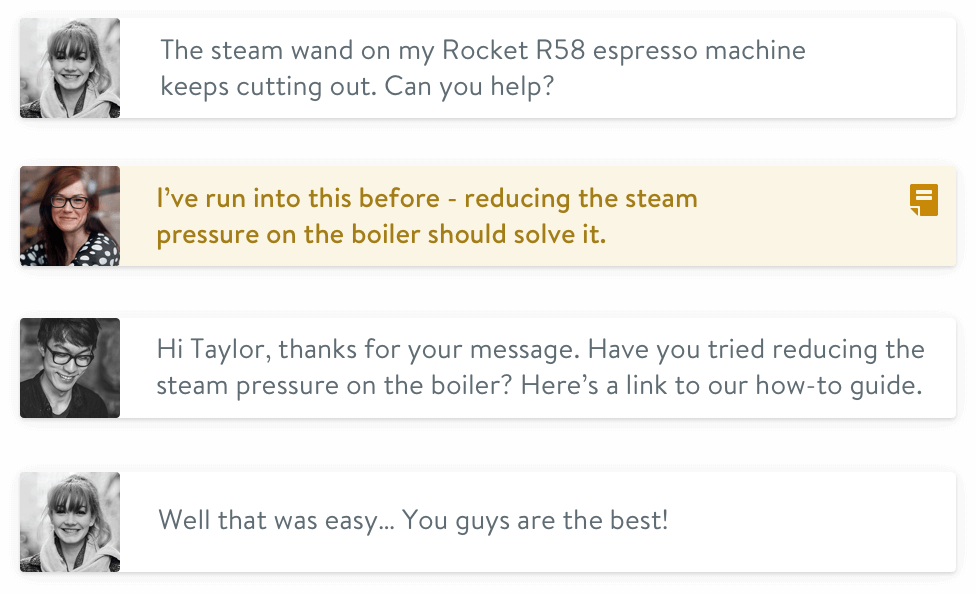Over the past few years, all hands support has been touted as the pinnacle of cross-company customer service collaboration. And yet, it’s still undervalued as a tool for minimizing barriers between businesses and their customers.
But all hands support has its issues too. While the expected benefits of an all hands approach are many, the notion that everyone in a company should participate in answering customer service is idealistic and naive.
When online store builder Big Cartel tried it in their business, they found that the support team felt ‘validated’ in the problems they were facing. But they also found customer satisfaction was severely impacted by replies from colleagues who simply didn’t have the required customer service skills.
“All Hands Support assumes that customer support is such an easy job that anyone in the company can do it well. I’m here to say that is absolutely incorrect… The rest of our team isn’t qualified to provide the excellent service that our users should expect from Big Cartel — and that is (rightfully) disappointing to our customers.”
Anna Brozek, Operations Director at Big Cartel.
If the goal of all hands support is to reduce barriers, scale support without hiring, and provide better customer service, those efforts become fruitless because all hands lowers the quality of your support.
The likely cause is that all hands support is not the real answer to those challenges. It’s a temporary fix that’s employed when strategic thinking is lacking.
Over the past three years more industries have recorded a dramatic decline in customer satisfaction than those who have improved, according to the Temkin Group’s 2017 Experience Ratings Report (a cross-industry open standard benchmark of customer experience).
To reverse this ratio, businesses need to realize that working better together is more important than ever. All hands support is just not the answer.
Why aren’t businesses collaborating better already?
While some teams are experimenting with an all hands support process, they are an exception. Customer service collaboration is largely seen as a novelty. Yet arguably it’s easier than ever before, so what’s holding businesses back?
Customer service isn’t valued
Customer service is often (wrongly) seen as the lowest rung on the ladder; it’s an afterthought, rather than (rightly) a valuable source of customer feedback. Customer service should be a net-profit department, and for many businesses, it’s the only interaction with humans post-purchase.
While growing numbers of support teams across industries are now being given a seat at the table, there’s still room for improvement. For most, the onus remains on the teams themselves to reposition and change the culture of customer support in their company.
Luckily, there are simple things you can do to be seen as the official voice of the customer within your company.
It’s important to be proactive by sharing customer feedback with other teams in a structured fashion. And most importantly, demonstrate how your team are already a profit-center.
Provide statistics on satisfaction, NPS, loyalty/retention rates, and exactly how your team generates a positive return on investment.
Recommended reading:
Other teams are too busy
“We’ve got a deadline,” is most likely an excuse. The real issue?
Teams are busy doing their own things related to their own OKRs (objective & key results) that are in their job description. Why should they invest time in contributing to something that’s not part of their role, and not going to help them?
This is your chance to prove how valuable your team’s knowledge and understanding is to the greater team.
Demonstrate how collaborating on customer service can help them get better at their own role.
For product management teams, that might mean dialing up the importance of receiving feedback direct from the source. Engineering teams can understand how their priorities are affecting customer sentiment. Marketing teams can discover what your customers really care about.
It’s key to be considerate of how other teams work. Your marketers might be more available to answer quick questions throughout the day, while you engineers may prefer to block out regular time to collaborate.

Letting other teams talk to customers is too risky!
Companies who have all hands support have written a lot about their training processes. They’ve done so to ensure that people from other teams have the right approach and skills to answering customer queries – but that can involve time and unnecessary training! It begins to make the process seem like more effort for less reward.
While your team might be superheroes, it’s unlikely they’re Superman, Wonder Woman, and Tony Stark at the same time.
Recognize that other people across your business are probably best placed to answer specific questions or provide expert opinion. Cement that into your support workflow.
We don’t have the budget to pay for part-time agent seats
Customer support is often held back by traditional help desks and processes that haven’t evolved since mainframes were the topic du jour. The tools teams use can make collaboration difficult and costly, and even impossible.
One of the problems is the concept of ‘tickets’.
On the face of it, they’re just text and a few tags. The valuable information – the context – is missing.
And for collaboration at scale, context is key to get the best answer for your customer as quickly as possible.
It’s clear that customer context is more valuable than ticket content. It’s the reason behind our new release. Customer Journeys and Conversations weaves useful and important customer behavior amid the conversations they’re having with your team. This allows your agents to be proactive, personal, and to create an effortless customer experience.
We understand that cost is a factor. We recognize it’s not economical to buy a full-price agent seat for a part-time user. This can soon negate potential ROI from better collaboration.
Kayako believes collaborating on customer support is so important we’ve baked it straight into our customer service software platform. Every support pricing plan includes free collaborators who can add internal context (without replying to customers directly). No more email-back-and-forth, and no more crossed wires!

Can your business afford not to work better together?
The benefits of greater collaboration between customer support and the rest of your business should not be shrugged at:
- Customers receive better, more efficient answers.
- Other teams understand the value of customer support, which validates your team and gets you a seat at the table.
- Those teams are closer to customers, meaning they can also do better in their day-to-day role.
This ultimately improves your product or service. A better product or service leads to higher customer satisfaction – bringing increased loyalty through repurchases and gaining new customers through word-of-mouth marketing.
Set meetings with other teams to start sharing information, customer feedback, and start adding value. Then, build a low-involvement and considerate collaboration process that melds the skills of your customer support team with expert knowledge and opinion from other departments. Start your journey to better collaboration today!
How does support collaborate with other teams in your business? We’d love to hear more about your process. Share your thoughts in the comments!

